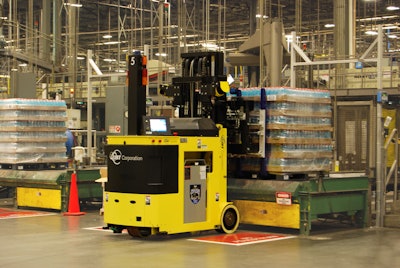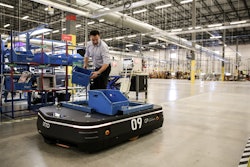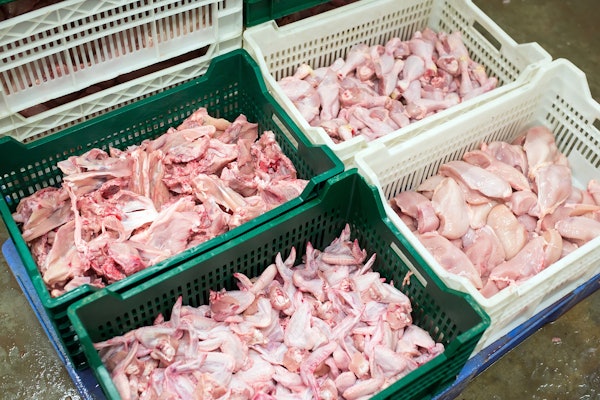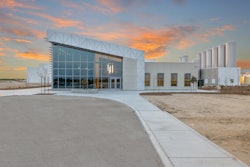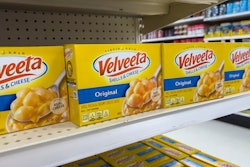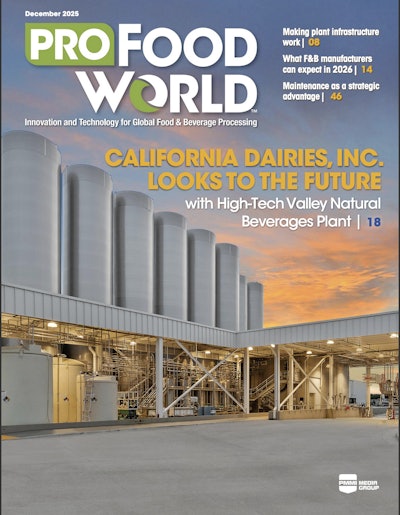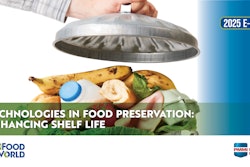Automatic guided vehicles (AGVs), once the domain of manufacturing operations like automotive plants, are making their way into food and beverage and consumer packaging applications, replacing manned forklifts for moving raw materials and finished products around the plant. “That industry is really starting to grow,” said Mark Longacre, marketing manager for AGV supplier JBT. “It started out in manufacturing, but food and beverage is really starting to grow.”
Although, fundamentally, the purpose of AGVs is to reduce the number of forklift drivers needed in a plant, they have other benefits as well, including reduced product damage; safer, more cost-effective movement of materials; and reinforced workforce discipline.
Longacre gave an Innovation Stage presentation during PACK EXPO last week in Chicago along with Brian Keiger, chief sales officer, intralogistics, for Grenzebach, another AGV supplier. They spoke together on behalf of MHI’s Automatic Guided Vehicle Systems (AGVS) industry group.
AGVs are not for every plant. Whether or not it’s a multiple-shift operation is an important consideration, according to Keiger, who said that’s usually his first question. If you’re running a one-shift operation, for example, payback is going to take a while—likely on the order of five years. “They travel a bit slower because they have to be safe, but they are consistent,” he said. “If you only have one shift, then it makes it very hard.”
For three-shift operations, though, it’s a no-brainer. Rather than having to hire multiple forklift drivers to cover multiple shifts, that same AGV can cover all three shifts. And the return on investment (ROI) is typically on the order of one to two years.
The space available is another important issue. “If you’re very constrained with space, you could end up with some blockage issues,” Keiger said, adding that you need to make sure there’s enough space for the AGVs to make turns as well.
Tangible benefits and ROI
But there are several situations where AGVs do make sense, particularly for facilities with routine/predictable delivery of stable loads. And in the right situation, the benefits are tangible.
Benefits include one that was the theme of many of the conversations at PACK EXPO this year: flexibility. For any manufacturer that has to answer to consumers, flexibility is key. “What’s the consumer good at? Changing their mind,” Keiger said. “You have to be able to adjust, be flexible, scalable, and grow your business. You need to be adaptable. AGVs allow you to do that.” That’s part of why AGVs are really catching on in the food and beverage industry.
Increased safety and reduced damage—to both the product and the facility—are also benefits. In one example that Longacre detailed, a beverage facility switched to AGVs to deliver full pallets of bottled product to warehouse storage lanes or directly into outbound trucks. They ordered 20 AGVs with double attachments, enabling each AGV to carry two pallets at a time. With a 24/5 operation, the payback was quick, Longacre said.
But they also found considerable payback with regard to damaged product. “They had a lot of problems with speared product,” Longacre said. “You not only waste all your effort and raw materials and everything that went into the product, but you’ve also got to clean it all up.”
They had also had trouble tracking product, Keiger noted. “Yes, with an AGV, you’re constantly tracking the product,” Longacre added. “So there’s no chance you’re going to lose product.”
Keiger and Longacre discussed a surprising lack of organization in some facilities, where items were not put back where they belong, and were often left lying in aisles. Because AGVs cannot travel through cluttered aisles, they can actually work as a motivator to keep workers more disciplined about keeping things in order. In at least one case that Keiger mentioned, a plant manager was looking forward to the order that AGVs could bring.
In a printing industry example, discipline was lacking among human workers in terms of efficiency as well. Somebody might take a load from one end of the plant to the other—not a short trip in what was a huge facility—then realize there was something else he should’ve brought along. He’d have to turn around and do the trip all over again. Instead, they installed 23 AGVs to shuttle materials from the automated storage and retrieval system (ASRS) to packaging and palletizing lines more efficiently and effectively.
Having to travel long distances is a common trait for facilities where AGVs make sense. As in the case with the beverage facility, using double attachments can make some facilities that much more efficient. In an example of finished goods movement, a packaging company used two long carriers to carry multiple loads, thereby replacing four forklifts with two tuggers, Keiger said. They reduced lost product and improved efficiency by 10 percent. “Their ROI was less than two years.”
Labor shortages
Although some might lament the threat of robots—mobile or otherwise—taking over manufacturing jobs, a labor shortage is becoming a real issue for many manufacturers. “I’m seeing this more and more,” Keiger said. “It’s a new generation; nobody wants to drive a forklift anymore.”
In the printing plant example that Keiger detailed, it was the labor shortage that drove them to explore AGVs in the first place. “They had about 3,000 jobs they were looking for,” he said. “After several months, they had 2,998 jobs they were looking for.”
At one plant in the food industry, they were facing average worker turnovers of 30 days. “It was very tedious, mundane work, which fit AGVs well,” Keiger said.
It means that some manufacturers aren’t as concerned about the ROI with AGVs anymore. “It’s becoming survival,” Longacre said. “If we keep going the way we are now, we’re not going to be staffed in 10 years. We’re not going to have enough people. If we expect to operate…and continue to have the throughput we have in these facilities, we’ve got to make a change.”
Worth a look
For any number of reasons, more and more production facilities are realizing the benefits of AGVs. In the many years that Longacre has been attending PACK EXPO, he has seen a distinct change take place. “The awareness is getting out there,” he said. “We’re seeing companies that are not just thinking about beta sites and first installations. They say they need to roll AGVs out to the entire enterprise.”
In examples cited, programs were so successful that they continued to roll out AGVs to their other facilities, Keiger said.
“I’m sure some of your competitors are using AGVs,” Longacre said. “It may not be right for you. It’s not right for every plant; for every application. But you need to give it a look.”
